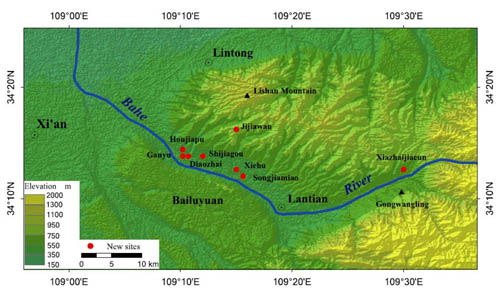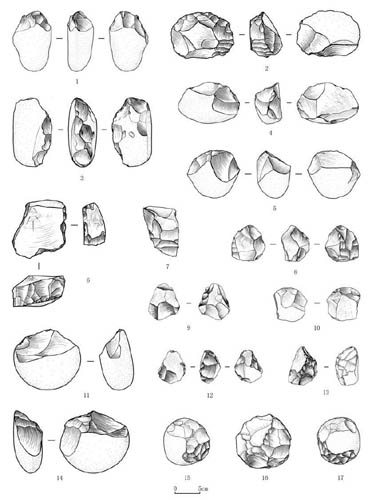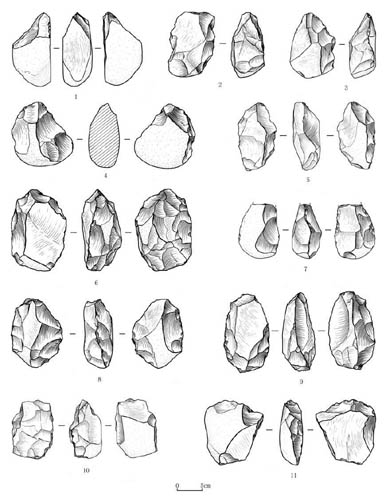The Bahe River valley of central China is regarded as one of the most important hominin sites from the late early Pleistocene to the middle Pleistocene. Homo erectus fossils were unearthed at the Gongwangling and Chenjiawo localities, and more than 30 Palaeolithic open-air sites were investigated in the 1960s in this region. However, the age, features and the assemblages of stone tools collected from the Lantian region were not well understood. Dr. WANG Shejiang, Institute of Vertebrate Paleontology and Paleoanthropology (IVPP) of the Chinese Academy of Sciences, and his collaborators discovered eight new Palaeolithic open-air sites and collected 770 stone artefacts from 2009 to 2011 in the Lantian area of the Bahe River valley, central China. According to a paper published in Chinese Science Bulletin 59(7), it is the first time that Acheulian-type large cutting tools from the late Pleistocene have been identified in this region. This study distinguishes age gaps between Western world and East Asian Acheulian-type tools.
These eight newly discovered open-air sites are located at the second (n = 6), third (n = 1) or higher terraces (n = 1) of the Bahe River. The Diaozhai section on the second terrace was sampled in detail. Two samples were collected for optically stimulated luminescence dating (OSL). The OSL results suggest that a buried lithic artefact layer at the Diaozhai site spans approximately from 70000 to 30000 years ago, helping better understand the Palaeolithic sequence and chronology of Homo erectus in the Lantian region, and accordingly extending the date range of early hominins’ activity from the early and middle Pleistocene to the later period of the late Pleistocene.
The lithic assemblage analysis suggests that the stone artefacts were made of local pebbles/cobbles such as greywacke, quartz, sandstone and igneous rocks. The main percussion techniques that were used were direct hard hammer percussion and bi-polar techniques. The lithic artefacts comprise hammer stones, cores, flakes, retouched tools and flaking debris. Acheulian-type large cutting tools such as hand-axes, picks and cleavers were indentified in the Lantian region as well.
According to current archaeological recordings, the Acheulian complex originated in Africa approximately 1.7 million years ago and spread to Europe and Asia with the dispersal of Homo erectus, lasting until approximately 0.2 million years, when Homo sapiens appeared and the Acheulian complex faded and was finally replaced by the Mousterian complex. “Our new discoveries of hand-axes, picks and cleavers indicate that the Acheulian large cutting tools in the Lantian region lasted until the late Pleistocene, which suggests that the Palaeolithic industry in East Asia had its own distinctive development pattern that perhaps differed from western Palaeolithic industry in terms of chronology”, said WANG Shejiang, lead author of the study.
He said, “when the transition from the Acheulian complex to the Middle Stone Age (MSA) was accomplished and blade technology finally appeared with the emergence of modern humans in Africa and Europe, the Acheulian complex, including hand-axes, cleavers and picks, nevertheless prevailed in the Qinling Mountains area and, of course, in East Asia. Therefore, this new discovery in the Lantian region may be considered valuable for identifying Palaeolithic industry characteristics in East Asia, the comparison between west and east world in terms of Palaeolithic culture and human behavior concerning modern human origins in East Asia”.
This work was supported by the One Hundred Talent Person Project of the Chinese Academy of Sciences, the Strategic Priority Research Program of the Chinese Academy of Sciences and the National Natural Science Foundation of China.

Fig. 1 The new Palaeolithic open-air sites in the Lantian region, central China (Image by WANG Shejiang)

Fig. 2 Newly collected lithic artefacts from the Lantian area. 1 Pick (or Hand-axe?); 2–4, 7, 10 Scrapers; 5, 11, 14 Choppers; 6 Core; 8, 9 Hand-axes; 12, 13 Points; 15–17 Spheroids. (Image by WANG Shejiang)

Fig.3 Newly collected lithic artefacts from the Lantian area. 1, 3 Picks; 2, 10 Cleavers; 4–9 Hand-axes; 11 Scraper. (Image by WANG Shejiang)


